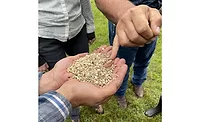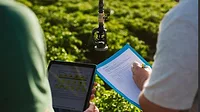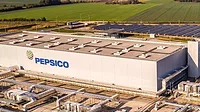Manufacturing News
“Regenerative” is Key to Agriculture/Water Sustainability

Photo courtesy of Getty Images / Maxvis
Three recent announcements from food and beverage companies use the word regenerative—either applied to sustainable agriculture or water. Today, the term connotes a concept something like the agriculture of the 1950s or earlier when small farms were the norm, and farm activities like rotating crops and spreading manure on the fields from the livestock prior to plowing and planting provided a soil rich in nutrients, requiring very little fertilizer input to get a good yield.
So old is new again, and fashionable—call it sustainable and hope it’s not a fad, but a real trend that produces a sustainable, healthier environment and food. According to the USDA site defining “sustainable agriculture terms,” regenerative agriculture was a term coined by Robert Rodale, which was expanded to “regenerative/sustainable agriculture” by the Rodale Institute and Rodale Research Center.
According to Robert Rodale [1], two reasons for emphasis on “regeneration” are:
- Enhanced regeneration of renewable resources is essential to the achievement of a sustainable form of agriculture
- The concept of regeneration would be relevant to many economic sectors and social concerns.
Today, technology—such as pH, humidity, nitrogen, oxygen and a host of other sensors combine with AI-based software—brings the old science up to date with the latest methods to get actionable information from inputs and crop yields, and weather/soil conditions as well.
Putting regenerative agriculture to work: Ardent Mills
Ardent Mills, a flour milling and ingredient company in partnership with Nutrien Ag Solutions, the retail division of a large crop inputs company, recently announced the advancement of its regenerative agriculture program. The program is focused on strengthening the soil ecosystem and helping producers improve their farms’ productivity and profitability. Ardent Mills has committed by the end of 2022 to enrolling 250,000 acres of spring and winter wheat into its regenerative agriculture program—with the goal of advancing regenerative agricultural practices and building the grower base over the next three years.
In cooperation with its producer partners and Nutrien Ag Solutions, Ardent Mills has built a regenerative agriculture program that aims to increase organic matter content and improve nutrient efficiency and water infiltration. The program uses key outcomes and provides side-by-side quality comparisons to understand thoroughly how regenerative agriculture affects the quality of wheat.
The regenerative agriculture program currently operates across 12 projects in nine geographies in the U.S. and Canada—including Alabama, Colorado, Idaho, Kansas, Montana, North Dakota, South Dakota, Pennsylvania, Texas and Saskatchewan. The initiative helps to serve Ardent Mills’ customers by providing valuable opportunities to meet their public sustainability goals and the needs of their consumers.
“Consumers are becoming increasingly curious about what’s in their food and choosing foods that align with their personal values. Sustainability is one of those key areas for many consumers,” says Shrene White, general manager, The Annex by Ardent Mills. “Not only does this program benefit the environment, but it also helps our customers meet those consumer demands. We’re excited to partner with our customers, growers and Nutrien Ag Solutions to continue this very important initiative.”
PepsiCo—moving toward a more sustainable food system while rethinking crops
PepsiCo has just released its 2020 sustainability report, which showcases progress toward a more sustainable food system. The report says there is much work to be done to address pressing challenges in the food system, such as climate change, fertile topsoil loss and packaging waste.
The report looks at two key areas where rethinking the growth and sourcing of crops is a must:
- Sustainably sourcing 100% of its direct commodities in 28 countries, with nearly 87% of direct commodities sustainably sourced globally as of 2020
- Announcing a new Positive Agriculture ambition that aims to spread regenerative practices across 7 million acres, improve the livelihoods of more than 250,000 people in its agricultural supply chain and sustainably source 100% of its key ingredients, including key crops from third parties, by 2030
“We are working to transform the way we create shared value by operating within planetary boundaries and inspiring positive change for the planet and people,” says Ramon Laguarta, PepsiCo’s chairman and CEO. “This will make us a better company, with purpose more deeply integrated into our business strategy. It will also make us faster and stronger, enabling accelerated growth and continued investment in our people, business and communities. And we hope it will make us an example for our partners and our peers.”
PepsiCo is also looking to reduce absolute GHG emissions across its value chain by 5%, improve operational water-use efficiency by 15% in high water-risk areas, continue efforts to reduce packaging waste to zero by converting to 100% rPET in 22 markets worldwide and complete its transition to 100% renewable electricity for its U.S. operations.
“2020 was a year of challenges and a year of change,” says Jim Andrew, chief sustainability officer, PepsiCo. “The challenges created by the COVID-19 pandemic impacted every corner of the globe and highlighted the urgent need to partner and drive change toward a more sustainable and resilient food system. I’m proud that PepsiCo rose to the challenge in 2020, and there’s no slowing down PepsiCo’s ambition to drive a positive impact on our planet and the communities we serve.”
Regenerating local water cycles
With climate change, water availability has been a challenging input, especially if a company’s product is bottled water. Nestlé Waters is expanding its current efforts to manage water sustainability and increase its collaboration with partners to support local solutions. These solutions are designed to help regenerate the ecosystems in the areas around each of Nestlé Waters’ 48 sites. As of 2025, the company expects to help nature retain more water than the business uses in its operations.
Nestlé’s new initiative builds on the company’s 2017 commitment to certify all of its Waters’ sites by the Alliance for Water Stewardship (AWS) by 2025. This standard requires water users to understand and act collectively on water challenges.
Nestlé will use its expertise to advance the regeneration of local water cycles through the implementation of more than 100 projects for its 48 sites by 2025, which will represent a $130 million investment. These new, measurable actions will support better water management and infrastructure. Project examples include:
- Buxton—Land conservation (protecting land from development) and natural flood management interventions in Derbyshire, UK
- Vittel—River restoration and renaturation projects in Vosges, France
- Nestlé Pure Life—Support for farmers to use drip irrigation in Sheikhupura, Pakistan
- Nestlé Pure Life—Delivery of water treatment, filtration and pipeline infrastructure for the municipal water supply in Benha, Egypt
Nestlé’s work will be tailored to individual locations, needs and issues and will take a broader approach, going beyond its own operations. The company will work with local water users, communities, partners and global experts to identify, develop and progress projects specific to those challenges.
All projects will be measurable, using the World Resources Institute’s Volumetric Water Benefit Accounting (VWBA) methodology. This methodology provides consistency in analyzing water management activities and helps to ensure that such activities address current and future shared water challenges.
“As a business with a long heritage of nature protection and water stewardship, we want to go beyond the conservation of water sources to help regenerate and restore water cycles in the areas where we operate,” says Cédric Egger, head of Sustainability at Nestlé Waters. “We know the water challenge is global, but it can only be tackled through local solutions. Now is the time to expand the scope of our actions. With Nestlé’s presence around the world, we can learn from our many partners and contribute to solving the water challenges in the locations near our operations.”
Resources:
[1] “Sustainability: An Opportunity for Leadership,” in Sustainable Agricultural Systems, ed. by Clive A. Edwards, et al. (Ankeny IA: Soil and Water Conservation Society, 1990), pp. 84-85. NAL Call # S494.5 S86S86
“Novel method to provide nitrogen to plants without nitrate pollution,” FE, June 2021
“Organic botanical biopesticides based on tea tree oil: Safe for the environment and people, FE, June 2021
“Regenerative agriculture initiative seeks worldwide participation,” FE, November 2020
“Organic Valley discusses the organic milk market and being environmentally-friendly,” FE, March 2018
Ardent Mills, https://www.ardentmills.com; https://www.facebook.com/ArdentMills/; https://twitter.com/ArdentMills; https://www.linkedin.com/company/ardent-mills
PepsiCo, https://www.pepsico.com/; https://www.facebook.com/PepsiCo; https://twitter.com/pepsico; https://www.linkedin.com/company/pepsico
Nestlé, https://www.nestle.com/; https://www.facebook.com/Nestle?brandloc=DISABLE; https://twitter.com/nestle; https://www.linkedin.com/company/nestle-s-a-
Looking for a reprint of this article?
From high-res PDFs to custom plaques, order your copy today!






